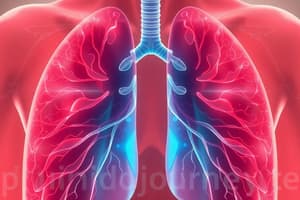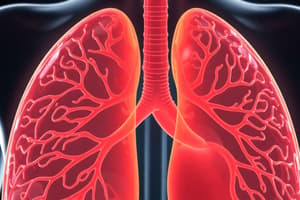Podcast
Questions and Answers
What is the primary location where gas exchange occurs in the respiratory system?
What is the primary location where gas exchange occurs in the respiratory system?
Gas exchange occurs primarily in the alveoli of the lungs.
Explain the mechanism of diffusion in the gas exchange process.
Explain the mechanism of diffusion in the gas exchange process.
Diffusion is the movement of gases from an area of higher concentration to an area of lower concentration.
How does surface area influence gas exchange efficiency?
How does surface area influence gas exchange efficiency?
A larger surface area facilitates more efficient gas exchange.
What role does hemoglobin play in gas transport?
What role does hemoglobin play in gas transport?
What happens during inhalation in the breathing mechanism?
What happens during inhalation in the breathing mechanism?
What is the significance of the ventilation-perfusion (V/Q) ratio in gas exchange?
What is the significance of the ventilation-perfusion (V/Q) ratio in gas exchange?
How do pathologies like asthma affect gas exchange?
How do pathologies like asthma affect gas exchange?
What factors can influence the rate of diffusion during gas exchange?
What factors can influence the rate of diffusion during gas exchange?
How do chemoreceptors contribute to the regulation of the gas exchange process?
How do chemoreceptors contribute to the regulation of the gas exchange process?
What role do alveoli play in the gas exchange process?
What role do alveoli play in the gas exchange process?
In what forms is carbon dioxide transported in the bloodstream?
In what forms is carbon dioxide transported in the bloodstream?
What impacts does chronic obstructive pulmonary disease (COPD) have on gas exchange efficiency?
What impacts does chronic obstructive pulmonary disease (COPD) have on gas exchange efficiency?
Why is maintaining a proper ventilation-perfusion (V/Q) ratio critical for effective gas exchange?
Why is maintaining a proper ventilation-perfusion (V/Q) ratio critical for effective gas exchange?
Flashcards are hidden until you start studying
Study Notes
Gas Exchange Process in the Respiratory System
-
Definition: Gas exchange is the biological process in which oxygen is absorbed from the environment and carbon dioxide is expelled from the body.
-
Location:
- Occurs primarily in the alveoli of the lungs, which are tiny air sacs that maximize surface area for gas exchange.
-
Mechanism:
- Diffusion: Gases move from an area of higher concentration to an area of lower concentration.
- Oxygen diffuses from alveoli (high concentration) into blood (low concentration).
- Carbon dioxide diffuses from blood (high concentration) into alveoli (low concentration) to be exhaled.
- Diffusion: Gases move from an area of higher concentration to an area of lower concentration.
-
Factors Influencing Gas Exchange:
- Surface Area: Larger surface area facilitates more efficient gas exchange.
- Partial Pressure: The difference in partial pressures of gases (O2 and CO2) across the alveolar membrane influences the rate of diffusion.
- Thickness of Respiratory Membrane: Thinner membranes increase the efficiency of gas diffusion.
- Ventilation-Perfusion (V/Q) Ratio: Optimal ratio ensures that air reaches the alveoli and blood perfusion is adequate for exchange.
-
Role of Hemoglobin:
- Hemoglobin in red blood cells binds to oxygen, increasing the blood's oxygen-carrying capacity.
- Oxygen binding is influenced by partial pressure and pH (Bohr effect).
-
Breathing Mechanism:
- Inhalation: Diaphragm contracts, increasing thoracic cavity volume, drawing air into the lungs.
- Exhalation: Diaphragm relaxes, decreasing thoracic cavity volume, pushing air out of the lungs.
-
Transport of Gases in Blood:
- Oxygen is mostly transported bound to hemoglobin.
- Carbon dioxide is transported as bicarbonate ions (HCO3-), dissolved in plasma, or bound to hemoglobin.
-
Regulation of Gas Exchange:
- Controlled by neural mechanisms and chemical sensors in the body that respond to CO2 levels and blood pH.
-
Pathologies Impacting Gas Exchange:
- Conditions like asthma, COPD, and pneumonia can impair gas exchange by affecting airflow or the structure/function of alveoli.
Gas Exchange
- Gas exchange is the process of oxygen entering the body and carbon dioxide leaving the body.
- It happens primarily in the alveoli of the lungs.
- Alveoli are tiny air sacs designed to maximize surface area for efficient gas exchange.
- Gases move through the respiratory system by diffusion, from an area of high concentration to an area of low concentration.
- Oxygen moves from the alveoli into the blood because the concentration of oxygen is higher in the alveoli and lower in the blood.
- Carbon dioxide moves from the blood into the alveoli because the concentration of carbon dioxide is higher in the blood and lower in the alveoli.
Factors Influencing Gas Exchange
- Surface Area: Larger surface area in the alveoli allows for faster and more efficient gas exchange.
- Partial Pressure: The difference in oxygen and carbon dioxide pressure between the alveoli and blood drives the diffusion process.
- Thickness of the Respiratory Membrane: A thinner membrane allows for faster diffusion of gases.
- Ventilation-Perfusion Ratio (V/Q): This ratio ensures that the amount of air reaching the alveoli matches the amount of blood flowing through the capillaries surrounding the alveoli.
Role of Hemoglobin
- Hemoglobin, a protein found in red blood cells, binds to oxygen, increasing the blood's oxygen-carrying capacity.
- The binding of oxygen to hemoglobin is influenced by partial pressure and pH, a phenomenon known as the Bohr effect.
Breathing Mechanism
- Inhalation: The diaphragm contracts, increasing the volume of the chest cavity, and drawing air into the lungs.
- Exhalation: The diaphragm relaxes, decreasing the volume of the chest cavity, pushing air out of the lungs.
Gas Transport in Blood
- Oxygen is primarily transported by hemoglobin.
- Carbon dioxide is transported in three forms: bicarbonate ions, dissolved in plasma, and bound to hemoglobin.
Regulation of Gas Exchange
- The body regulates gas exchange through a combination of neural mechanisms and chemical sensors.
- These sensors detect changes in carbon dioxide levels and blood pH, triggering the appropriate response.
Pathologies Affecting Gas Exchange
- Conditions like asthma, chronic obstructive pulmonary disease (COPD), and pneumonia can all impair gas exchange.
- These conditions affect the structure and function of the respiratory system, leading to reduced airflow or impaired gas exchange in the alveoli.
Gas Exchange Definition and Location
- Gas exchange is the process of absorbing oxygen and expelling carbon dioxide.
- This process occurs in the alveoli, tiny air sacs in the lungs.
Mechanism of Gas Exchange
- Inhalation: Air enters the lungs through the trachea, bronchi, and bronchioles. Oxygen then diffuses across the alveolar membrane into the bloodstream.
- Diffusion: This process is driven by differences in partial pressure, meaning oxygen moves from areas of high concentration (alveoli) to low concentration (blood in capillaries). Carbon dioxide moves in the opposite direction due to higher concentration in the blood.
Oxygen Transport
- Oxygen binds to hemoglobin in red blood cells for transportation.
- Small amounts of oxygen also dissolve directly in plasma.
Carbon Dioxide Transport
- The majority of carbon dioxide is transported in plasma as bicarbonate ions (HCO3-).
- A small amount is also transported dissolved in plasma and bound to hemoglobin.
Regulatory Mechanisms
- The medulla oblongata and pons in the brain control breathing rate and depth based on CO2 levels in the blood.
- Chemoreceptors in the body detect changes in blood pH and gas concentrations, further influencing breathing.
Factors Affecting Gas Exchange
- Surface area: More alveoli increase the surface area for gas exchange, improving efficiency.
- Thickness of respiratory membrane: Thinner membranes allow for faster diffusion of gases.
- Ventilation-perfusion ratio: Efficient matching of air flow to blood flow enhances gas exchange efficiency.
Pathologies Impacting Gas Exchange
- Asthma: Inflammation and narrowing of airways hinder airflow and gas exchange.
- COPD (Chronic Obstructive Pulmonary Disease): Impairs airflow and reduces gas exchange efficiency.
- Pulmonary Embolism: Blood clots block blood flow to part of the lung, severely impacting gas exchange.
Importance of Gas Exchange
- Gas exchange is crucial for cellular respiration as cells require oxygen for energy production.
- It also removes carbon dioxide, a metabolic waste product, helping to maintain acid-base balance within the body.
Studying That Suits You
Use AI to generate personalized quizzes and flashcards to suit your learning preferences.




